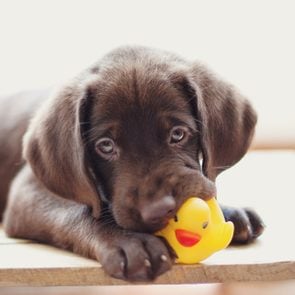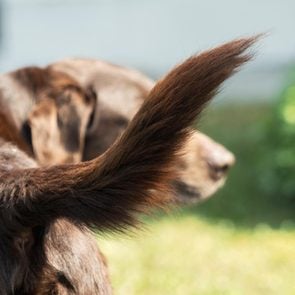Why Do Dogs Put Their Paws on You?
Updated: Apr. 10, 2024
You talk with your hands. Why shouldn't your dog? We asked canine behaviorists to explain what it really means when your dog puts its paw on you.
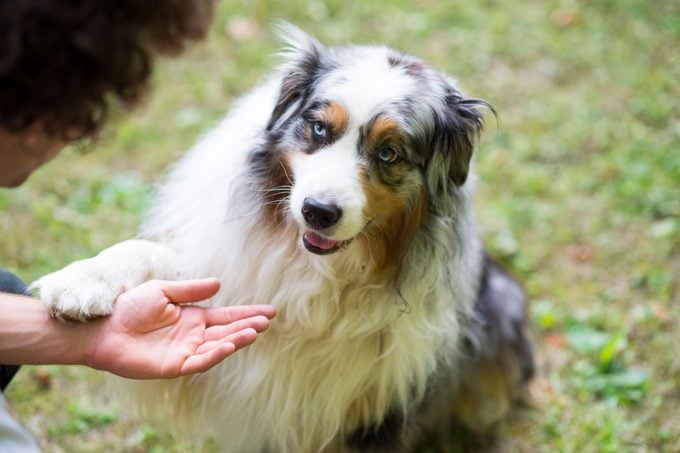
It’s an all-too-familiar scenario: You’re watching TV or attempting to work when you’re interrupted by your dog pawing at your leg. That small action can turn any pet owner into an amateur sleuth bent on answering a single question: Why do dogs put their paw on you? Do they want attention? Did you forget to serve dinner? Or are they just saying “hello”?
Let’s face it: Dogs can be a total mystery sometimes. If only we could ask them what they were thinking, we would have a much better time understanding dog behavior. And the more we understand what our dogs are trying to accomplish, the better we can respond. That might involve giving a dog affection or teaching it a less demanding way to communicate.
In over 13 years as a certified professional dog trainer—and even longer as a dog owner—I’ve been pawed plenty of times. It’s especially common during training classes; it doesn’t take much time for my canine clients to sniff out the freeze-dried liver in my pockets. That’s given me particular insight into the question of why dogs put their paw on you. Luckily, we have a very good idea of their motivations. Read on to learn the different things dogs are saying with their paws.
Get Reader’s Digest’s Read Up newsletter for more pet insights, humor, travel, tech and fun facts all week long.
About the experts
|
Why do dogs put their paws on you?
Chances are, your dog learned that pawing you is a great way to get a response. As veterinary behaviorist Isabelle Bazin, MV, DES, of the Daubigny Veterinary Center in Quebec City points out, pawing is hard to ignore. “It might happen through trial-and-error learning, but because there is physical contact, there is a good chance the human is going to react,” she says. But what are you reacting to? Is your dog pawing to ask for something, or is it just an annoying way to demand affection? Let’s look at the top reasons dogs use their paws.
They’re communicating with you
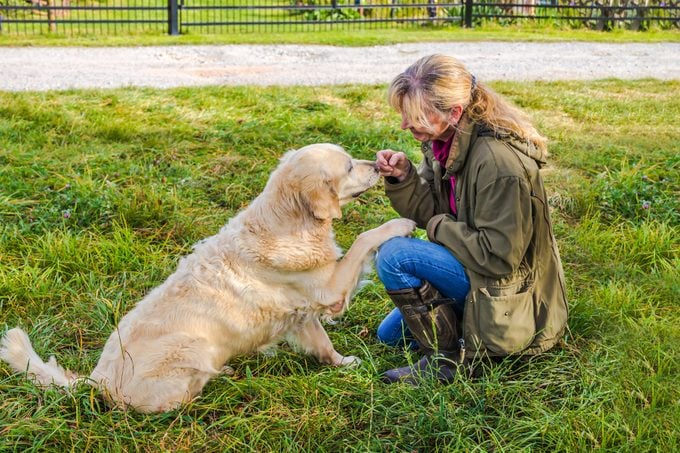
Dogs communicate using vocalizations, olfactory signals, facial expressions and body language, says certified behavior consultant and dog trainer Rachel Lane, CBCC-KA, CPDT-KA, MSc, owner of the dog-training company Leash & Learn. Their body language repertoire is vast, and it includes the use of their paws. So just as your dog stares at you to tell you something, it may also put its paw on you.
Certified behavior consultant and dog trainer Valerie Balwanz, CBCC-KA, CPDT-KA, points out that dogs use their paws to communicate with other dogs too. “Dogs will often paw at another dog in an attempt to get them to play,” she says. “Because dogs include us in their social circles, they use these communication signals with us too.”
Just how much communicating a dog will do with its paw depends on the pup’s personality. When a dog lacks frustration tolerance (the ability to deal with frustrations), the behavior is even more noticeable. Are you taking too long to prepare your dog’s dinner or folding the laundry when it’s time for a walk? Be prepared to feel that paw.
You can use that pawing behavior to your advantage, though, especially if you enjoy trick training with your dog. “If your dog is using their feet a lot, it’s fun to capitalize on this and teach them some tricks where they would use their paws, such as ‘shake,’ ‘high-five,’ ‘wave’ or ‘hit a buzzer,'” Balwanz says.
They’re showing affection
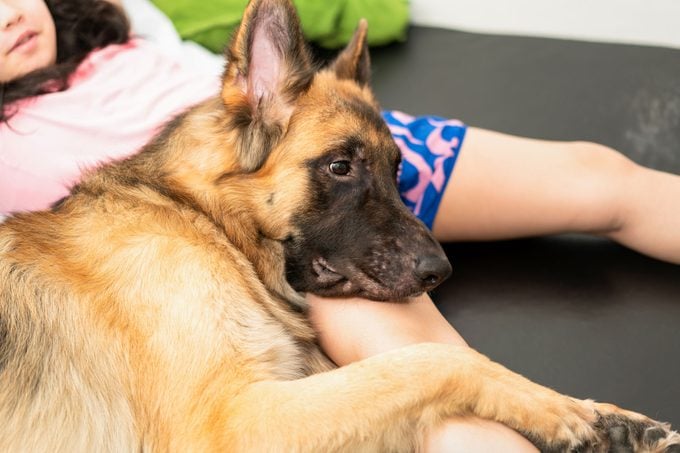
Rather than scratching at their favorite human, some dogs like to rest their paws on people in what looks like the canine version of holding hands. Why do dogs put their paw on you in this way? And do dogs love you if they put their paw on you?
Balwanz says dogs enjoy being in physical contact with people they know and trust. “If your dog is pawing at you to ask for petting or resting their paw on you while cuddling, it certainly indicates a special level of comfort and affection they wouldn’t exhibit with a stranger,” she says.
Dr. Bazin agrees that some dogs are looking for ways to be in contact with their family members. You probably recognize that your dog lying side by side with you is a sign of trust and love. Resting a paw on you is another way for your dog to show how it feels. And although it seems like a stripped-down version of cuddling together, it doesn’t mean your pup likes you any less.
They’re trying to get your attention
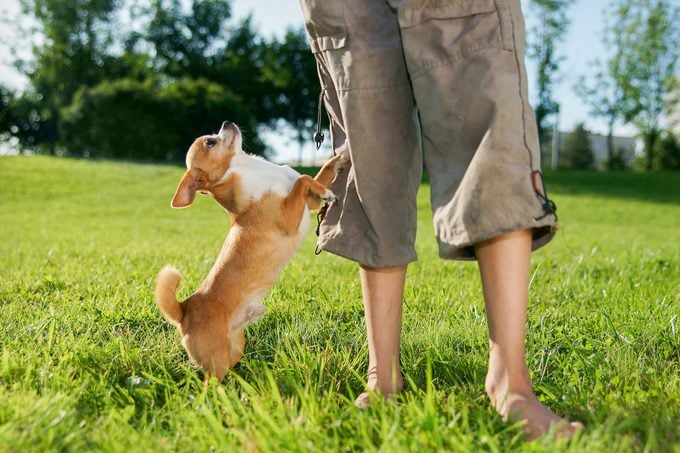
Another reason dogs paw at you is because they’ve learned it’s a great way to get your attention. “Dogs repeat behaviors that work to get them something that they want,” Balwanz explains. “In the case of pawing at you, there is a good chance your dog tried this once, or it happened accidentally, and it resulted in something that they wanted, probably your attention. Your dog learned ‘pawing at my person makes them pay attention!’ The pawing then gets repeated and works again. Because it works, your dog keeps doing it.”
In Dr. Bazin’s opinion, pawing is usually related to attention-seeking. “I think most of these dogs have been taught to shake a paw, and they have learned that when they do that, people are very happy. The dogs get treats, and they get attention. Then they try to reproduce that to get treats or attention in other contexts.”
They need something
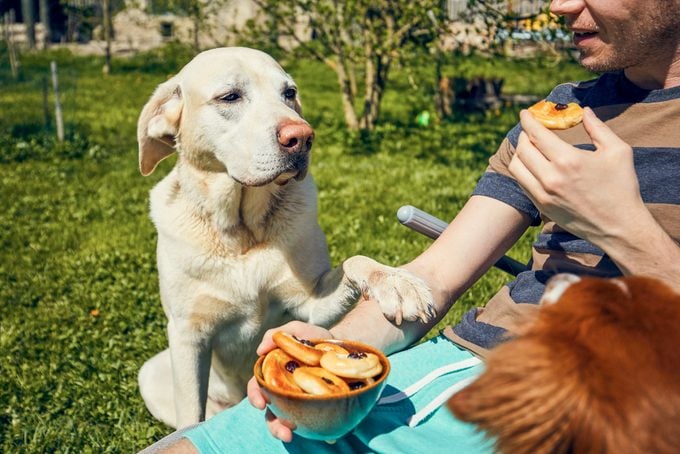
Lane points out that there are other rewards for putting a paw on somebody besides attention. For example, the dog might like food, time to play, a chance to go for a walk or the opportunity to potty outside.
Why do dogs put their paw on you when they want something instead of, say, barking or rubbing up against you? Chances are, your dog has used pawing to get something in the past. Now it sees the action as a way to express its needs.
Dr. Bazin says that when something works, and pawing usually does, the dog is going to continue that behavior and won’t try another way to get what it wants as long as it keeps working. Therefore, if you fill your dog’s water bowl when it paws at you, you’ve now established pawing as a way to ask for water. Your thirsty pooch won’t ask for water with a different behavior until you stop responding to pawing by filling the water dish.
They’re bored
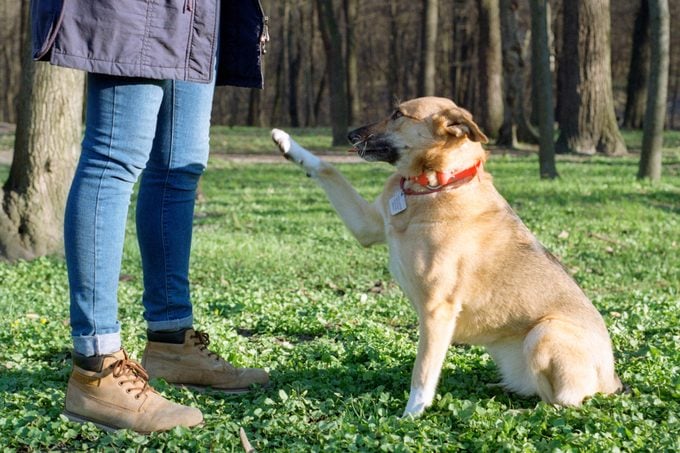
Our pups know that we’re often the bearers of entertainment, providing them with games and toys. So they may paw at us when they’re bored. “They know that the person is often the source of reinforcers, and they are looking for something to do or some sort of enrichment,” says Lane. The best way to handle that is to provide for your dog’s needs. If you’re too busy to play, for example, she suggests giving your dog some sort of puzzle toy or a food-stuffed toy to help prevent pawing.
Dr. Bazin advises prevention first. For instance, if your dog regularly paws you at a certain time of day to tell you it has to go potty, schedule your walks for that time so your dog won’t need to ask. And keep those enriching toys in your dog’s environment so it can use them to stay physically and mentally active. “Then he will ask less of you at those times because he’s better in general,” she says.
They’re anxious
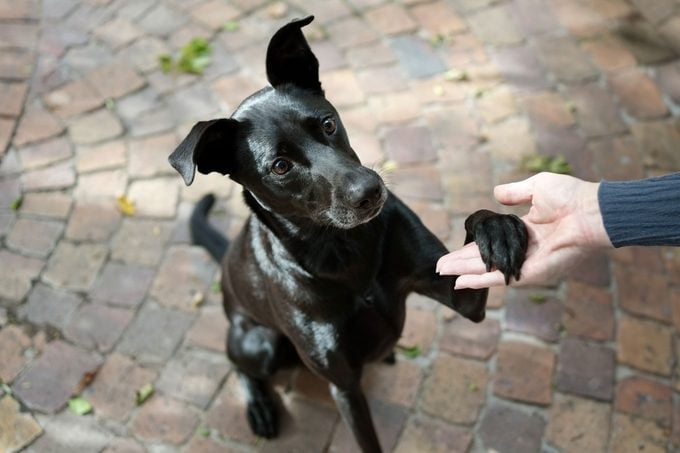
Although pawing can be normal in certain circumstances, excessive pawing may be a sign of dog anxiety. Dr. Bazin recently saw a dog that, when staying with the owner’s mother, would paw the mother 10 to 15 times a day to get whatever it needed, including potty breaks and treats. It was a nervous dog that had a hard time resting and calming down, and pawing was a way for it to express its stress and anxiety.
Of course, you’ll know if your dog is acting out of anxiety only if you assess the entire situation. Dr. Bazin recommends looking at the dog’s body language. I always look for subtle signs, including a tucked-in tail, pulled-back ears, lip licking and yawning.
Putting a paw on you may be a way for your dog to seek social support, says Lane. It can be a signal that your pup feels ill-equipped to deal with its current situation and is asking you for help. She suggests you respond to this kind of pawing, as your dog needs you at that moment.
“This can help dogs learn healthier ways of coping with stress in the future, as well as develop a positive relationship between dog and owner,” says Lane. “When a dog is pawing at the person because they are anxious, it is also important to work with a dog trainer or behavior consultant to address the underlying anxiety and fear so that it resolves in the future.”
How to stop a dog’s pawing habit
If you’ve provided for your dog’s daily needs, including sufficient exercise and mental stimulation, and it is still pawing at you, that’s likely because it has learned that pawing gets it what it wants. In that case, to eliminate the behavior, you need to ignore it completely.
Dr. Bazin warns that, when training your dog out of this behavior, you shouldn’t move toward or look at your dog when it’s putting its paw on you—even a glance is attention. You might think you’re punishing your dog by yelling, “Bad dog!” But that could actually be reinforcing because it’s attention, and that’s what the dog is looking for.
Be aware that when a behavior is no longer reinforced, such as when you ignore your pup, the intensity of that behavior will likely increase before it gets better. If you react in that moment, you will only create an even bigger problem, so you absolutely must continue to ignore the behavior until it finally disappears. It can be a long process, and it requires consistency and the entire family’s participation.
The last part of breaking your dog’s pawing habit is to reinforce the behavior you would like to see in its place. It’s essential to never take good behavior for granted. “If you want your dog to bring the ball instead of pawing at you, then if he brings the ball to you, please give him attention and give him a treat,” says Dr. Bazin. “You’re going to reinforce the behavior you really want in your dog.”
Why trust us
At Reader’s Digest, we’re committed to producing high-quality content by writers with expertise and experience in their field in consultation with relevant, qualified experts. For this piece, Stephanie Gibeault, MSc, CPDT-KSA, tapped her experience as a certified professional dog trainer and journalist, and then Wailani Sung, DVM, a vet with a board certification in veterinary behavioral medicine who owns Bay Area Vet Behavior, gave it a rigorous review to ensure that all information is accurate and offers the best possible advice to readers. We relied on reputable primary sources, including certified canine behaviorists and dog trainers, as well as our writer’s personal experience. We verified all facts and data and backed them with credible sourcing, and we will revisit them over time to ensure they remain accurate and up to date. Read more about our team, our contributors and our editorial policies.
Sources:
- Valerie Balwanz, CBCC-KA, CPDT-KA, certified behavior consultant, dog trainer and owner of Dog Training by Valerie; email interview, March 10, 2024
- Isabelle Bazin, DVM, DACVB, veterinary behaviorist at the Daubigny Veterinary Center in Quebec; video interview, March 13, 2024
- Rachel Lane, CBCC-KA, CPDT-KA, MSc, certified behavior consultant, dog trainer and owner of Leash & Learn; email interview, March 11, 2024


